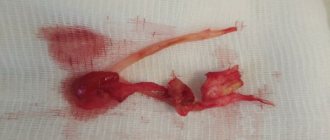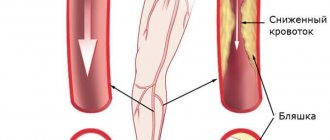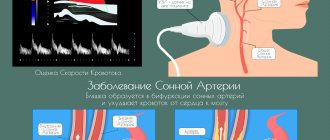- What is atherosclerosis of the lower extremity vessels?
- Symptoms of the disease
- Risk factors
- Stages of development of atherosclerosis of the lower extremities
- Diagnostics
- Treatment
- Conservative treatment
- Surgical techniques
- Possible consequences and prevention
- Popular questions
Obliterating atherosclerosis (OA) of the arteries of the lower extremities
is a chronic vascular disease, which is based on lipid metabolism disorders, leading to the formation of atherosclerotic plaques, thickening of arterial walls and a decrease in the vascular lumen. As a result, ischemia develops - insufficient oxygen supply to cells and tissues.
Most often the popliteal, femoral and tibial arteries are involved in the pathological process.
OA of the arteries of the lower extremities is in first place among diseases of the peripheral arteries of atherosclerotic origin. According to literature data, obliterating arterial diseases account for about 16% of all vascular diseases Source: Podrezenko E.S. The influence of risk factors on the development of obliterating atherosclerosis of the vessels of the lower extremities / E.S. Podrezenko, S.S. Dunaevskaya // Health is the basis of human potential: problems and ways to solve them. - 2012. - pp. 576-578. .
Symptoms of atherosclerosis of leg vessels
The development of the disease occurs gradually and in the first stages there may be nothing to show for it. Subsequently, the patient develops pain in the lower extremities, especially with prolonged walking, and a feeling of numbness in the feet. A decrease in temperature is felt on the legs, pallor and cyanosis are visible, and cramps occur. Over time, a person develops intermittent claudication and trophic changes occur in the form of delamination of nails and the formation of ulcers on the fingers and heels.
- with atherosclerosis, the patient may feel and observe the following:
- muscle pain in the legs, in the later stages even the feet hurt, and the pain cannot be relieved with painkillers;
- limited mobility of the affected leg;
- pain along the affected artery - first during physical activity, then at rest;
- intermittent claudication - after walking some distance, a person is forced to stand up and give his legs a rest, and then he moves on until the next attack of weakness;
- tingling, numbness in the affected area;
- thickening of nails;
- loss or slow growth of hair on the legs;
- paleness when raising the legs and sharp redness when lowering them;
- rapid freezing of feet;
- sores on the skin;
- purple fingers;
- absence of pulsation in the affected artery;
- areas of darkening on the skin are signs of the onset of gangrene in advanced stages;
- coldness of the skin of the leg;
- reduction in the mass and volume of the muscles of the thighs and legs.
At the beginning of the disease, as a rule, one limb suffers, then the process becomes symmetrical - this is a signal that the arteries are affected on both sides. An objective examination reveals the absence of pulsation in the popliteal fossa, thigh and ankle.
How does the disease manifest itself?
With atherosclerosis of the extremities, a person begins to experience sharp pain when walking and lameness appears. After walking short distances, the patient feels terrible fatigue, stiffness in movements, cramps, and his toes go numb. It seems that the leg suddenly became unbearably heavy, as if a weight had been put on it. Typically, one leg is affected by atherosclerosis of the lower extremities. After rest, the pain goes away, but not for long.
Cause of numbness in legs
Probably each of us remembers this unpleasant feeling when our legs go numb and you simply can’t feel them. This includes tingling throughout the body, a “chill,” and a feeling of temporary paralysis of the limbs. There are different reasons for this:
- uncomfortable sitting position, when nerve endings are compressed;
- diabetes mellitus;
- poor circulation in the legs,
- manifestation of osteochondrosis;
- lack of vitamins in the body;
- migraine;
- multiple sclerosis;
- inflammation of the nerves in various diseases: arthritis, etc.
Fortunately, numbness in the legs is not always a harbinger of serious illness. However, this is always a reason to immediately contact a vascular surgeon.
Risk factors for the development of atherosclerosis of the lower extremities:
- age 40 -50 years;
- male gender;
- large amounts of alcohol;
- smoking;
- high cholesterol levels;
- diabetes mellitus;
- hypertension;
- stress;
- sedentary and sedentary lifestyle.
Risk factors
The development of OA is based on the following most significant risk factors, the degree of influence of which can be different Sources: 1. Kuznetsov M.R. Basic principles of diagnosis and treatment of obliterating atherosclerosis of the arteries of the lower extremities / M.R. Kuznetsov // General medicine. - 2008. - No. 1. - P. 3-8. 2. Podrezenko E.S. The influence of risk factors on the development of obliterating atherosclerosis of the vessels of the lower extremities / E.S. Podrezenko, S.S. Dunaevskaya // Health is the basis of human potential: problems and ways to solve them. - 2012. - pp. 576-578. 3. Fattakhov V.V. Obliterating atherosclerosis of the lower extremities in the practice of a polyclinic surgeon / V.V. Fattakhov // Practical medicine. - 2010. - No. 2 (41). — P. 126-130. :
- male gender (men get sick 10 times more often);
- age (over 40 years);
- poor nutrition;
- overweight (obesity);
- smoking tobacco;
- hypokinesia (insufficient motor activity);
- hypofunction of the thyroid and gonads;
- heredity;
- some concomitant diseases (diabetes mellitus, coronary heart disease, heart rhythm disorders, lipid and carbohydrate metabolism, hypertension);
- exposure to adverse environmental factors.
Risk groups and concomitant diseases for atherosclerosis of the vessels of the lower extremities:
- male gender (distribution of disease: 85% men, 15% women);
- age 50 years and older, although the disease is getting younger;
- hereditary factor;
- smoking;
- diabetes;
- hypertension (high blood pressure);
- high cholesterol (infatuation with fatty foods);
Signs (symptoms) and stages of the disease
The main symptom signaling the onset of blockage of the arteries of the lower extremities is the so-called “intermittent claudication.”
When walking, pain appears in the muscles of the legs, which is characterized as “fettering”, “squeezing”, the leg seems to “go wooden”. The pain intensifies when running or climbing stairs. The location of the pain zones depends on the location of the compressed (affected) areas of the arteries. The most common pain is in the calf muscles. But pain can also occur in the muscles of the thighs and buttocks, which indicates damage to large arteries: the iliac, abdominal aorta. The extent to which circulation is impaired can be understood by the distance that the patient travels before the first attacks of pain appear.
Stages 1 and 2 : pain in the lower extremities after 500-1000 meters of walking, the toes go numb, the leg is cold, the skin of the lower leg and foot turns pale.
Stage 3 : pain occurs when walking short distances, up to 100 meters, hair loss on the lower leg, foot and toes, the skin acquires a purplish-bluish tint, wounds heal poorly, nail growth slows down, and deformation occurs.
Stage 4 : the legs hurt at rest, in a horizontal position, the pain temporarily subsides when lowering the legs down, then intensifies. Necrosis and tissue necrosis begin, non-healing trophic ulcers appear. Men experience impotence.
Stage 5 : gangrene of the leg develops, starting from the foot. Only surgical intervention and limb amputation can help save the patient’s life.
Atherosclerosis of the lower extremities occurring against the background of diabetes mellitus is especially dangerous. The disease progresses rapidly and leads to necrotic lesions and gangrene in just a matter of days and even hours.
Diagnosis of atherosclerosis of the lower extremities in our Center
Only comprehensive diagnostics using modern diagnostic systems provides reliable information on what stage of the disease the patient is at and what forms and methods of treatment will be most effective.
During the initial free consultation, the patient is interviewed and examined, complaints are listened to, visible changes in the skin are noted, and lesions are identified.
Further diagnosis of arteries is carried out using non-invasive painless methods: ultrasound scanning (ultrasound duplex scanning of the vessels of the lower extremities).
The walls of blood vessels are examined and assessed by a specialist, the speed of blood flow is established, and obstacles that disrupt healthy circulation are identified.
In severe forms of the disease, tests and additional diagnostic methods are prescribed (CT angiography of leg vessels, measurement of partial pressure of oxygen in tissues) in order to assess the patient’s condition in detail before surgery.
Modern treatment of atherosclerosis of the lower extremities
In the initial stages, it is possible to combine the use of medications and the use of physiotherapy, which includes a set of exercise therapy exercises and dosed (short) walking.
If there is a slight partial narrowing of the artery section, stenting is used: the affected artery is punctured, a catheter with a stent is inserted, which, using a compressed air cylinder, opens, expanding the narrow section and is fixed, thereby restoring blood circulation.
In case of serious disruption of blood flow, when the blocked areas of the vessels are prolonged, surgical methods are used to restore blood circulation:
- prosthetics or bypass surgery with a synthetic prosthesis (alloprosthesis);
- prosthetics or bypass with an autologous vein: using your own vein, a bridge is created, a bypass from the proximal to the distal end, that is, bypassing the blocked area;
Profundoplasty is a surgical correction effective in terms of clinical results, which is performed for patients with occlusion of the superficial femoral artery and stenosis of the deep femoral artery with chronic ischemia of the lower extremities of severe stages. For this, endarterectomy from the deep femoral artery and angioplasty with a patch are used, which can be the patient’s vein or artery or special artificial synthetic substitutes. Today, profundoplasty is a method with highly proven effectiveness, which can be used to reduce the degree of ischemia and reduce the risk of limb amputation.
What to do for atherosclerosis of the arteries of the lower extremities
The first thing you need to know. Atherosclerosis is not a death sentence. Despite the fact that the vessels cannot be restored to their original form, with timely access to a vascular surgeon, the patient has every chance to continue to live and work fully. But even with serious changes and lost time, there are great hopes for the successful finalization of the process, which consists of preserving the lower extremities while following the doctor’s simple recommendations in the postoperative period. In our clinic, qualified vascular surgeons literally rescue people from the other world who were rejected by other medical institutions. We urge you not to be indifferent to your health, get free consultation, and, if necessary, stop atherosclerosis using modern methods of vascular surgery. Your operation can be performed free of charge, as it is high-tech assistance and is subject to quotas from budget funds.
Stages of development of atherosclerosis of the lower extremities
The most detailed is the modified classification of chronic arterial insufficiency of the lower extremities (CANF), which takes into account in detail the phenomena of critical limb ischemia, which is necessary when determining treatment tactics.
| Stage 1 | Muscle pain only during heavy physical activity (when walking over a distance of more than 1 km). Initial signs of stenosis appear - the skin turns pale, there is a feeling of goosebumps, it seems that the legs are always cold, fatigue quickly sets in when walking, excessive sweating is observed |
| Stage 2A | Feeling of fatigue and stiffness in the calf muscles, intermittent claudication after 200-1000 m |
| Stage 2B | Intermittent claudication in less than 200 m |
| Stage 3A | Intermittent claudication after a few steps or pain at rest when it is possible to keep the lower limb in a horizontal position for more than 2 hours |
| Stage 3B | Pain at rest, ischemic edema, inability to keep the lower limb in a horizontal position for 2 hours |
| Stage 4A | Gangrene of the fingers or part of the foot with the prospect of maintaining the supporting function of the limb |
| Stage 4B | Extensive necrotic changes in the limb without the possibility of maintaining its supporting function |
Diagnosis of atherosclerosis
The diagnosis is based primarily on the results of laboratory tests and data from instrumental research methods.
A conversation with a patient only allows us to identify risk factors for the development of diseases and, together with an examination, as well as consultation with other specialists, suggest which organs have already been affected by the disease. Diagnosis of atherosclerosis necessarily includes:
- Blood chemistry.
- Ultrasound of the heart and blood vessels.
- Electrocardiography.
A high predisposition to the development of the disease is indicated by changes such as an increase in the concentration of total cholesterol, triglycerides, low- and very low-density lipoproteins, and a decrease in the amount of high-density lipoproteins.
Innovative risk factors for atherosclerosis include C-reactive protein (CRP), apolipoproteins A1 (apoA1) and B-100 (apoB), some polymorphisms of endothelial synthase genes (NOS3G894T, NOS3T(-786)C) and blood coagulation factors FV and FII. To obtain accurate results of a blood test for atherosclerosis, three days before the test you should give up fatty, cholesterol-rich foods, and 8-10 hours before, eat nothing at all and drink a lot of liquid. 30 minutes before the test, you should avoid strong emotional stress, stress, and do not smoke.
Echocardiography clearly shows signs of atherosclerosis of the heart valves and aorta. According to indications, ultrasound scanning of the brachiocephalic, transcranial, and arterial vessels of the lower extremities is also performed.
Reflects disturbances in heart rhythm and electrical conductivity of the organ. Exercise testing may be performed to detect exertional angina.
The standard list of laboratory tests also includes a general clinical blood test and a general urinalysis.
Additionally, for the purpose of differential diagnosis, blood tests for the level of fibrinogen, homocysteine, antibodies to cardiolipin (IgG and IgM), and lupus anticoagulant may be recommended. To visualize atherosclerotic plaques, according to indications, angiography is used - an X-ray examination with the introduction of a contrast agent. In case of preparation for surgery on the heart vessels, coronary angiography is performed.
The “gold standard” for diagnosing pathological changes in the arteries of the brain and parenchymal organs is spiral computed tomography with contrast.
Often such patients are recommended to consult an ophthalmologist. Fundus ophthalmoscopy reveals signs of atherosclerotic damage to small retinal vessels.
Diagnostics
There is a standard diagnostic program for this disease:
- Ultrasound of vessels of the lower extremities (duplex and Doppler scanning);
- coagulogram (determination of the blood coagulation system);
- determination of cholesterol and LDL levels in the blood;
- leg arteriography;
- establishment of pulsation in peripheral arteries;
- MR, MSCT angiography.
If prescribed by a doctor, MRI and CT scans with contrast and rheovasography can be performed.
To make a timely diagnosis of atherosclerosis of the vessels of the lower extremities, consultation with a vascular surgeon or phlebologist and a number of diagnostic measures are necessary.
Due to the systemic nature of the atherosclerotic process, patients with OA of the lower extremities often experience combined damage to various arterial basins, therefore, in such patients, an integral part of instrumental diagnosis is the study of extracranial and coronary arteries. Identification of pathology in them may require a change in treatment tactics or the order of surgical interventions Source: Kuznetsov M.R. Basic principles of diagnosis and treatment of obliterating atherosclerosis of the arteries of the lower extremities / M.R. Kuznetsov // General medicine. - 2008. - No. 1. - P. 3-8. .
Diagnosis of atherosclerosis of the extremities
To make a correct diagnosis and find out whether you have atherosclerosis of the lower extremities, you need to undergo a full examination. This will help to identify the degree of vascular patency and blood supply to the legs, determine the level of occlusion and the extent of vascular pathology in atherosclerosis.
1 Determination of pulsation of arteries of the extremities
2 Determination of pulsation of arteries of the extremities
3 Determination of pulsation of arteries of the extremities
To do this you need:
- get advice from a vascular surgeon;
- measure blood pressure in the arms and legs;
- determine the pulsation of the arteries of the limbs;
- undergo MCT angiography;
- undergo duplex scanning of peripheral arteries.
1 Consultation with a vascular surgeon in MedicCity
2 Ultrasound of arteries in MedicCity
3 Ultrasound of arteries in MedicCity
Treatment of atherosclerosis of the vessels of the lower extremities
The approach to treatment is determined depending on the stage of the disease and is primarily about choosing the right regimen. It is necessary to adhere to a diet limiting fried and fatty foods, eliminating smoking and alcohol, as well as combating excess weight. The patient should follow a walking and physical activity regimen, choose comfortable and spacious shoes, and treat even the smallest injuries on the skin of the lower extremities. Treatment of concomitant chronic diseases is mandatory.
Medicinal methods include anticoagulants, antiplatelet drugs, agents that improve blood microcirculation, vasodilators, and physiotherapeutic procedures.
In severe cases, surgical treatment may be necessary.
General recommendations:
- normalize weight;
- follow a diet with low cholesterol;
- give up alcohol and smoking;
- wear shoes that fit;
- do not overcool your feet;
- even minor injuries should be carefully treated and treated;
- trim nails carefully without damaging soft tissues;
- engage in moderate physical activity - walking, swimming, cycling or exercising on an exercise bike.
Treatment of obliterating atherosclerosis
One of the treatment methods is electrotherapy.
Source: Nicole Patterson / YouTube The choice of treatment method is determined by the severity of symptoms, the stage of development of the pathological process, and the nature of the course of the disease. Depending on the patient’s condition, conservative therapy or surgery is prescribed.
Conservative therapy
Conservative treatment includes medications, physiotherapy, and spa treatment. It is also necessary to eliminate risk factors for the development of the pathological process - quit smoking, normalize lipid metabolism and blood pressure. Conservative methods give a positive effect only at the initial stage of the disease.
The complex of drug therapy includes the following drugs:
- reducing red blood cell aggregation;
- thin the blood and prevent the formation of blood clots;
- antispasmodic;
- vitamins;
- painkillers.
Physiotherapeutic techniques:
- electrophoresis;
- UHF;
- magnetic therapy and others.
These procedures are aimed at improving blood circulation and strengthening the walls of blood vessels in the lower extremities.
For obliterating atherosclerosis, balneological procedures are indicated. They accelerate metabolic processes and activate blood circulation: radon, hydrogen sulfide and other baths, applications with healing mud.
To heal trophic ulcers, dressings with drugs that promote skin healing and accelerate the process of tissue regeneration are prescribed.
Surgery
Surgery is indicated in later stages of the disease and in the absence of effect from conservative treatment.
The choice of surgical intervention method is determined by the individual characteristics of the pathology and the degree of arterial damage. Modern surgery offers several effective methods of endovascular or open surgery:
- arterial stenting - installation of a special frame to prevent narrowing of the vascular bed;
- endarterectomy - excision of atherosclerotic plaques on the inner wall of the vessel;
- thromboembolectomy - removal of thrombotic masses from the affected arteries;
- bypass - creating a path to bypass the affected area of the artery;
- replacement of the affected artery with a prosthesis or a segment of the patient’s own healthy vein;
- profundoplasty – expansion of the affected area by plastic surgery.
If surgery is not possible, palliative measures are taken to improve blood circulation.
You should not delay contacting a doctor, because at stage 4 the pathological process can only be stopped by amputating the affected leg to a level that takes into account the boundaries of the ischemic lesion. At the same time, timely assistance, such as reconstructive vascular surgery, will make it possible to save the limb with a high probability.
Treating atherosclerosis
- Shishkin A.A.
- Volkov A.M.
- Kabirov A.V.
- Baranov V.S.
Shishkin Andrey Andreevich
Candidate of Medical Sciences. Surgeon, proctologist, phlebologist at SM-Clinic. Proficient in all modern methods of conservative and surgical treatment of diseases of the veins of the lower extremities (including sclerotherapy, EVLT - endovasal laser coagulation, traditional phlebectomy)
Read moreVolkov Anton Maksimovich
Phlebologist, surgeon at SM-Clinic. Performs operations with a modern proprietary method of treating varicose veins using a laser (modified endovenous laser coagulation. M-EVLC).
Surgical treatment of varicose veins of any complexity (phlebectomy, miniphlebectomy) More detailsKabirov Alexander Vitalievich
Cardiovascular surgeon at SM-Clinic. Candidate of Medical Sciences Proficient in all modern methods of conservative and surgical treatment of diseases of the veins of the lower extremities (including sclerotherapy, EVLT - endovasal laser coagulation, traditional phlebectomy)
More detailsBaranov Vladimir Sergeevich
Cardiovascular surgeon at SM-Clinic. Candidate of Medical Sciences Treats lower varicose veins using non-surgical and surgical methods (aesthetic sclerotherapy, ECHO sclerotherapy, stem sclerotherapy, phlebectomy, miniphlebectomy, EVLT).
More details
Symptomatic interventions:
- Sympathectomy
(intersection of the nerve plexuses responsible for spasm (narrowing) of the arteries) is performed for repeated blockages of the arteries and in addition to reconstructive operations. This operation improves blood circulation in the extremities by dilating small arteries. - Revascularization osteotomy
is also an adjuvant technique that improves blood circulation by stimulating the formation of new small vessels in the lower extremities after bone injury. - Arterialization of the venous bed
is rarely used at this time, since its implementation is associated with various technical difficulties, and long-term results are worse than the methods described above.
Conservative treatment
The patient may be prescribed various medications:
- prevent the formation of blood clots, prevent stroke and heart attack;
- increasing physical activity, improving blood flow in the lower extremities;
- antiplatelet drugs that lower blood cholesterol levels;
- anticoagulants, which prevent blood clotting in blood vessels and prevent blood clots;
- antispasmodics to relieve pain and spasms;
- antimicrobial ointments that need to be used to treat trophic ulcers;
- medications that promote better tissue nutrition;
- vasodilators;
- vitamins.
Also, as part of conservative therapy, physiotherapy is performed - electrophoresis with novocaine, darsonvalization, hyperbaric oxygenation.
What it is
The pathology is associated with the development of a degenerative process in the peripheral arteries supplying the lower extremities.
This is one of the most common types of atherosclerosis - deposits of cholesterol and calcium salts on the walls of blood vessels and the formation of numerous plaques that sharply impede blood flow. Narrowing of the lumen of the arteries and poor circulation in the lower extremities leads to severe pain when walking and numbness of the feet. This syndrome is called intermittent claudication. As the pathology progresses, the pain becomes constant, and trophic ulcers and necrotic areas appear on the skin in the foot area.
The main problem in the treatment of obliterating atherosclerosis is associated with late seeking medical help, when pathological changes in blood vessels are irreversible.
Obliterating atherosclerosis often begins at a young age, but occurs without any symptoms. With age, clinical manifestations gradually become more pronounced, and if in people aged 50 years the pathology is diagnosed in only 1.1% of the population, then by the age of 70 this figure increases to 5.2%.
In older people, the disease usually occurs against the background of other chronic pathologies and damage to several arterial basins by atherosclerotic plaques. The disease is especially severe in patients with diabetes.
The pathological process in obliterating atherosclerosis affects the inner layer of blood vessels, consisting of a layer of endothelial cells - the intima. Around the fatty deposits on the vessel wall, connective tissue begins to grow and fibrous plaques form, to which platelets “stick.” Next, calcium salts begin to deposit on the affected tissues, creating a serious obstacle to blood flow.
The pathology is life-threatening to the patient: if you do not consult a doctor in a timely manner and if it lasts for a long time, the risk of high limb amputation increases. Every fourth patient dies after amputation, and half of the patients die in the first year after diagnosis, even if amputation was not performed. Narrowing of the arteries and prolonged stagnation of blood in the vessels of the lower extremities threatens the formation of blood clots, the development of gangrene and sepsis.
Surgical techniques
Surgery is a last resort and is usually prescribed for severe ischemia and very severe complications. Nowadays, different types of surgical interventions are performed. Some involve a day hospital, some require a long-term hospital stay under observation. Patient rehabilitation plans and post-operative care vary. Our doctors advise patients in detail on all aspects related to surgical intervention and carefully monitor their health in the pre- and postoperative period.
Surgical treatment of atherosclerosis of the lower extremities:
- bypass surgery - an additional “bypass” path for blood flow is created around the area of narrowing of the artery;
- stenting - a special tubular spacer is placed in the affected vessel, which ensures the required diameter of the artery;
- balloon angioplasty - similar to stenting, only a balloon is inserted into the vessel cavity rather than a spacer, which expands its lumen;
- autodermoplasty - if trophic ulcers are poorly treated conservatively, they are operated on and covered with the patient’s own skin;
- endarterectomy - removal of the affected part of the artery in which the atherosclerotic plaque is located;
- prosthetics – replacement of the affected vessel with the patient’s own vein, taken from another place, or with a synthetic prosthesis;
- amputation - prescribed in severe cases when gangrene occurs, after which prosthetics are performed.
In 75-85% of cases, after surgery, blood circulation is completely restored for an average of 5-8 years.
Indications for surgery:
- an aneurysm that may rupture;
- chronic ischemia of critical stage;
- hemodynamically significant carotid artery stenosis or plaque accompanied by symptoms of cerebral ischemia;
- decompensation of blood circulation in the leg due to embolism, trauma, thrombosis.
Contraindications to surgical treatment:
- wet gangrene with sepsis;
- severe disruption of vital organs - renal and liver failure, circulatory disorders in the brain, myocardial infarction, heart failure, etc.
Treatment
In the early stages of the disease, drug treatment aimed at preventing the development of atherosclerotic plaques and improving the rheological properties of blood is acceptable. For this purpose, statins and antiplatelet agents (aspirin) are used.
If the lumen of the vessel is so closed that the blood supply to the limb is disrupted, surgical treatment is necessary:
- balloon dilatation and stenting of the vessel (expansion of the narrowed part and installation of a stent to prevent re-narrowing of the lumen),
- endarterectomy (removal of plaque with the inner layer of the vessel),
- shunting (creating bypass paths for blood flow around an irreversibly damaged area of the vessel).
Possible risks associated with the disease
The disease is insidious in that it is impossible to predict its course and symptoms. Approximately 20% of patients over 65 years of age, having severe plaques, do not feel any discomfort. The seriousness of the progressive course of OA ANC is also due to the fact that after the appearance of the first symptoms, 10-40% of patients develop gangrene within 3-5 years, which leads to amputation of a limb or death Source: Kazantsev A.V. A new approach to surgical tactics for obliterating atherosclerosis of the arteries of the lower extremities / A.V. Kazantsev, E.A. Korymasov // Saratov Medical Scientific Journal. - 2010. - T. 6. - No. 4. - P. 850-856. .
Atherosclerosis can be complicated by arterial thrombosis. This complication, if not immediately sought by a doctor, leads to loss of a limb or embolism of other arteries. If the clot detaches and enters the coronary artery, a myocardial infarction may develop, and if it migrates to the carotid artery, a stroke may occur.
Prognosis and prevention
Source: PhotoMIX Company: Pexels
The effectiveness of treatment and the overall prognosis for obliterating atherosclerosis depend on the time of initiation of therapy, the degree of arterial damage and the presence of concomitant pathologies. Therapy is particularly difficult when other vessels, cerebral or coronary, are simultaneously affected.
The most dangerous complication of the disease is gangrene, which has a high probability of death. Its development can only be prevented by emergency amputation of the affected limb.
Prevention measures are aimed at reducing the risk of developing atherosclerosis and include the following recommendations:
- normalize your diet and give up high-fat foods;
- do not smoke or drink alcoholic beverages;
- devote time to moderate physical activity, such as swimming, cycling or even just walking;
- keep your feet clean;
- wear comfortable shoes with low heels;
- Avoid injuries and cuts to the skin on your legs.
Timely treatment can stop the development of the pathological process and significantly improve the patient’s quality of life.
Prevention methods
For prevention purposes, you need to start controlling the levels of lipids, sugar and cholesterol in the blood as early as possible. Even with a slight increase in numbers relative to the norm, you should consult a doctor. It is also recommended to regularly do ultrasound of the lower extremities - once every 1-2 years.
It is important to watch your diet, because the reason for the increase in “bad” cholesterol in the blood is the saturated fats that we consume in food. These are products of animal origin - fatty meat, lard, butter. There is a lot of cholesterol in eggs, or rather in the yolks. All these products should be consumed in the smallest possible quantities.
| Name of service (price list incomplete) | Price, rub.) | In installments* |
| Appointment (examination, consultation) with a cardiovascular surgeon, primary, therapeutic and diagnostic, outpatient | 1 750 | — |
| Program “Risk of atherosclerosis and ischemic heart disease, predisposition to dyslipidemia” | 19 000 | — |
* You can read more about the conditions here - Treatment on credit or in installments.
Causes
The main cause of the disease is systemic atherosclerosis. The formation of cholesterol plaques on the walls of blood vessels of the lower extremities is associated with the same pathological mechanisms that cause vascular damage in any other place.
Factors in the development of atherosclerosis:
- dyslipidemia – an imbalance in the content of fats (triglycerides and lipoproteins) in the blood;
- weakness and loss of firmness and elasticity of the vessel wall;
- disruption of cellular metabolism;
- genetic predisposition.
Risk factors for developing pathology:
- gender – men suffer from atherosclerosis several times more often than women;
- age – the disease usually begins to progress after 40 years;
- smoking - nicotine has a vasoconstrictor property and negatively affects the condition of the walls of blood vessels;
- overweight;
- unhealthy diet – a large amount of fat in the diet worsens lipid metabolism and contributes to the formation of cholesterol deposits;
- sedentary lifestyle;
- hormonal disorders;
- unfavorable environmental conditions.
Source: freepic.diller / ru.freepik.com
People with chronic diseases are predisposed to obliterating atherosclerosis: hypertension, endocrine disorders, ischemia and a number of others.
Prevention of atherosclerosis
For patients with a family history and age-related predisposition, a screening examination is recommended to determine the risk of developing cardiovascular pathology.
It aims to detect laboratory and genetic markers of the disease. Prevention of atherosclerosis includes weight control, proper nutrition, sufficient physical activity, giving up bad habits, and timely treatment of chronic diseases.
Author:
Pugonina Tatyana Alekseevna, Therapist
Which doctor should I contact?
Atherosclerosis of the lower extremities is a common disease, since the factors causing it are present in the lives of many people. Poor diet, smoking, etc. - these are the scourges of our time, which make disabled people out of young people by the age of 40.
Cardiologists and phlebologists treat ischemic diseases. If we are talking about the need for surgical intervention, vascular surgery can be performed by an angiosurgeon. In any case, contacting specialized specialists is the first step towards health and preventing the risk of disability or death from atherosclerosis of the lower extremities.
Make an appointment with a specialist, without queues, at a convenient time
+7
Sign up
Prices for consultation and appointment with a cardiologist
| Name | Price |
| Blood pressure measurement | 60,00 |
| Consultation after MRI/MSCT | 540,00 |
| Initial consultation with a pulmonologist | 1800,00 |
| Initial appointment with a cardiologist (consultation) | 1800,00 |
| Initial appointment with a rheumatologist | 1800,00 |
| Repeated consultation with a pulmonologist | 960,00 |
| Repeated appointment with a cardiologist | 960,00 |
| Repeated appointment with a rheumatologist | 960,00 |
| Preoperative examination by a cardiologist (doctor’s appointment, ECG, interpretation) | 2460,00 |
| ECG interpretation | 600,00 |
| Taking an ECG | 360,00 |
| 24-hour blood pressure monitoring | 2400,00 |
| 24-hour Holter ECG monitoring | 3000,00 |
| ECG with stress | 1950,00 |










